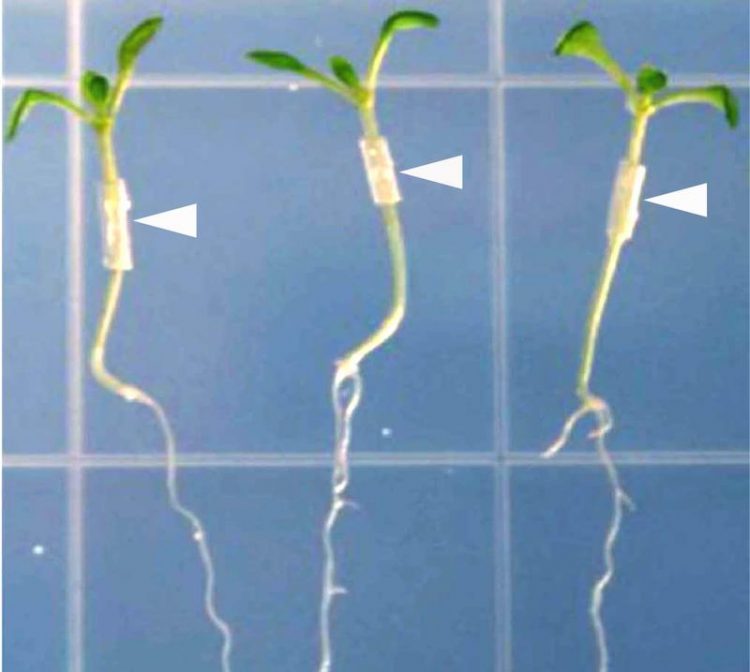From leaf to root – messenger RNAs are long-distance travellers

Heterografts of the Arabidopsis ecotypes Columbia and Pedriza were used to analyze mobile mRNAs. White arrows indicate grafting sites. © Max Planck Institute of Molecular Plant Physiology
Plants take up water and salts from the soil and they produce sugars via photosynthesis. These nutrients need to be transported to growing tissues adjacent to their uptake or synthesis. This task is assumed by the vascular bundles, which consist of two tissues: xylem and phloem. Water and dissolved salts are transported from root to shoot by the xylem.
The phloem facilitates transport sugars and other organic compounds from nutrient exporting tissues (sources) to importing tissues (sinks). Besides small molecules, proteins and siRNAs (small interfering RNAs) are transported in the phloem as well.
“Small interfering RNAs take part in gene regulation. They are able to migrate long distances, e.g. from leaves to flowers where they can regulate the production of pollen or phosphate uptake in the root”, explains Friedrich Kragler of the Max Planck Institute of Molecular Plant Physiology in Potsdam. Moreover there were hints on phloem transport of larger RNA molecules like messenger RNAs (mRNAs). They convey genetic information from DNA to protein synthesis.
“Only a small number of mRNAs that were found in the phloem have been analyzed further. In addition it was unknown to what extent mRNAs are transported between distant tissues”, says Friedrich Kragler. On this account the international team of scientists investigated the mobility of mRNAs in the model plant Arabidopsis thaliana (thale cress). First they needed to develop a method which enables distinction of mobile and immobile mRNAs. Migration of mRNA from shoot to root and vice versa could be analyzed in heterografted plants.
“Due to their genetic variety, we chose to use different Arabidopsis ecotypes for our grafting experiments”, says Wolf-Rüdiger Scheible of the Samuel Robert Noble Foundation in Ardmore, Oklahoma. Ecotypes are genetically distinct populations within one species that are adapted to different ecosystems. The scientists decided to use two out of over 750 Arabidopsis subspecies: Columbia (Col-0) from Missouri and Pedriza (Ped-0) from Spain. They harbor substantially diverged genetic information. So, mRNAs can be easily assigned to one of those ecotypes.
Seedlings were used for root-shoot heterografting in various combinations. Two weeks after grafting, DNA and RNA of leaves and roots were isolated und subjected to sequencing. “By analyzing the obtained sequence data we could identify 2006 genes that produce mobile mRNAs”, explains Friedrich Kragler, “although the true number actually might be even higher as our approach could not interrogate all mRNAs that are produced in these Arabidopsis ecotypes” adds Wolf-Rüdiger Scheible.
The majority of detected mobile mRNAs migrates in the phloem, matching the sugar transport. The other half splits in molecules that migrate from root to shoot (25%) and those that are transported in both directions (24%). The scientist assume that plants use mobile mRNAs as signal molecules to coordinate growth processes as well as adaptation to environmental stresses in distant tissues.
Grafting is commonly used in viticulture and fruit cultivation to combine characteristic traits of two varieties. Nevertheless, the underlying genetic determinants are often unknown. “Knowing the identity of mobile mRNAs that move from roots into flowers will help us to understand why certain graft combinations e.g. used widely by plant breeders with grapevines, tomatoes, or with apple trees are beneficial or detrimental for fruit production”, says Friedrich Kragler.
KD
Contact
Dr. Friedrich Kragler
Max Planck Institute for Molecular Plant Physiology
Phone: +49 331 567-8120
kragler@mpimp-golm.mpg.de
http://www.mpimp-golm.mpg.de/6650/3kragler
Dr. Kathleen Dahncke
Press and public relations
Max Planck Institute for Molecular Plant Physiology
Phone: +49 331 567-8275
dahncke@mpimp-golm.mpg.de
http://www.mpimp-golm.mpg.de
Original publication:
Christoph J. Thieme, Monica Rojas-Triana, Ewelina Stecyk, Christian Schudoma, Wenna Zhang, Lei Yang, Miguel Miñambres, Dirk Walther, Waltraud X. Schulze, Javier Paz-Ares, Wolf-Rüdiger Scheible and Friedrich Kragler
Endogenous Arabidopsis messenger RNAs transported to distant tissues
Nature Plants, 23 March 2015, DOI: 10.1038/nplants.2015.25
http://www.mpimp-golm.mpg.de/6650/3kragler Link to Friedrich Kraglers group
Media Contact
All latest news from the category: Life Sciences and Chemistry
Articles and reports from the Life Sciences and chemistry area deal with applied and basic research into modern biology, chemistry and human medicine.
Valuable information can be found on a range of life sciences fields including bacteriology, biochemistry, bionics, bioinformatics, biophysics, biotechnology, genetics, geobotany, human biology, marine biology, microbiology, molecular biology, cellular biology, zoology, bioinorganic chemistry, microchemistry and environmental chemistry.
Newest articles

Silicon Carbide Innovation Alliance to drive industrial-scale semiconductor work
Known for its ability to withstand extreme environments and high voltages, silicon carbide (SiC) is a semiconducting material made up of silicon and carbon atoms arranged into crystals that is…

New SPECT/CT technique shows impressive biomarker identification
…offers increased access for prostate cancer patients. A novel SPECT/CT acquisition method can accurately detect radiopharmaceutical biodistribution in a convenient manner for prostate cancer patients, opening the door for more…

How 3D printers can give robots a soft touch
Soft skin coverings and touch sensors have emerged as a promising feature for robots that are both safer and more intuitive for human interaction, but they are expensive and difficult…





















